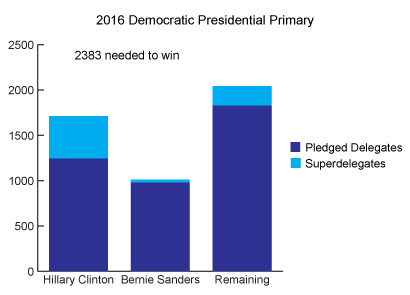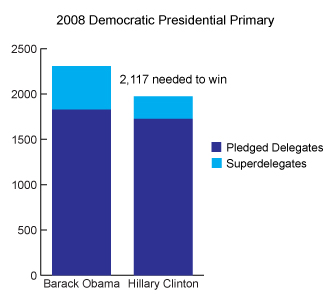Superdelegates. Until this election, you probably never heard of them. So what are they and why are they important? Let’s back up for a second and look at the bigger picture: delegates.
The process for selecting the Democratic presidential nominee is complex.* Each state is allocated a certain number of delegates based on their population and party loyalty, with bonus delegates being awarded for the state’s voting history, current Democratic elected officials, and other party-related factors. Combined, these make up the “pledged delegates” for the state. Each state has different rules, but they all hold either a primary or a caucus in which the voters give input on the candidate they want to be the party’s nominee. The pledged delegates are awarded roughly proportionately to the voters’ input, with the exception that any candidate receiving less than 15% of the vote doesn’t receive any delegates. Most states also have rounding rules, as well as county or state level conventions, that make the eventual outcome slightly less proportional to the original vote. But typically, if a state has 100 pledged delegates and Candidate A gets 60% of the vote and Candidate B gets 40%, then about 60 pledged delegates would be awarded to Candidate A and 40 awarded to Candidate B.
So where do superdelegates come in? This requires a bit of a history lesson to explain. For a long time, party elites selected the nominee and voters didn’t influence the selection process. State primaries and caucuses have been held since the early 1900s, but were largely ignored by the party. Then, in 1968 after a disastrous election cycle, the Democratic party changed their nomination rules to be more responsive and transparent to voters. But some party leaders felt the 1968 rules went too far, and in 1982 they implemented a plan to reintroduce their influence. They created unpledged delegates, commonly known as superdelegates. These superdelegates were Democratic party leaders and elected officials that could vote for whomever they chose at the national convention, regardless of their state’s voter preference. For this election cycle, there are 719 superdelegates and 4,046 pledged delegates, 15% to 85% (numbers are approximate for complicated reasons…half-votes, strange state rules, etc.).
All of the delegates – pledged and unpledged – travel to the Democratic National Convention, which this year will be held July 25-28 in Philadelphia. There they will hold a vote, and the candidate with the simple majority of delegates voting for them will win the nomination.
The idea behind superdelegates was to prevent a nominee who would fail to deliver in a general election and to provide a more organized national convention process. Since superdelegates were instituted, they have never voted against the popular vote. In fact, they are intended to stabilize it. Because the pledged delegate selection process is so complicated, the number of delegates a candidate racks up doesn’t necessarily correspond with the popular vote. The superdelegates were meant to be a stabilizing voice to select both the candidate that the people want and the person who can win the general election. Which brings us to the current race…

Pledged delegate & superdelegate count as of April 3, 2016.
The people may eventually choose Sanders through the popular vote and pledged delegates, but the party elites / superdelegates may continue to believe Clinton is the more electable in the general contest. As of April 3, 2016, Sanders has 980 pledged delegates to Clinton’s 1,243, a difference of 263. This is fairly close when you consider there are still 2,042 delegates up for grabs. But the media tends to skip over this fact and instead focuses on the combined pledged delegates and superdelegates count, currently at Sanders 1,011 to Clinton 1,712. Clinton has 469 superdelegates to Sanders’ mere 31. But there’s an important footnote: the superdelegates haven’t voted yet. This count is based on public declarations of support from superdelegates, most of whom declared for Clinton before Sanders was a real contender. The actual vote won’t be held until the national convention in July. And it’s not clear if superdelegates will continue to support Clinton if Sanders wins more pledged delegates. It’s a close enough race that the superdelegates could influence who gets the nomination…but at what cost? To overrule the voters in a close contest would not only alienate the voter base of their own party, but cement claims that the DNC is actively aligned against Sanders.

The 2008 Democratic Presidential Primary was a close contest too. Superdelegates at the national convention could have swept Clinton in as the nominee, but many opted to support Obama, who had the higher pledged delegate count.
The superdelegates early declaration of support is a potentially self-fulfilling prophecy. They give the impression that Clinton is further in the lead, enticing more voters to support her. But in 2008, many of Clinton’s superdelegate supporters defected to Obama once it became clear she would not become the nominee. Obama had a lead of only 102 pledged delegates. The superdelegates could have swept Clinton in as the nominee at the national convention, but they supported the candidate with more pledged delegates. It looks like this year’s contest will be just as close, so it will be interesting to see what happens if Sanders closes the pledged delegate gap.
*The Republican primary system is similar but even more complex due to looser rules on state caucuses and primaries.
Sources
- “2016 Democratic Delegate Allocation Rules by State.” Frontloading HQ.
- “A Brief History of Superdelegates.” Daily KOS. Feb 15, 2008.
- “Could Superdelegates Really Stop Bernie Sanders?” New Republic. Dayen, David. Feb 11, 2016.
- “Democratic Party presidential primaries, 2008.” Wikipedia. Accessed Apr 2, 2016.
- “Everything you need to know about delegate math in the presidential primary.” The Washington Post. Sides, John. Feb 16, 2016.
- “List of Democratic Party superdelegates, 2016.” Wikipedia. Accessed Feb 3, 2016.
- “Sanders pressures Clinton superdelegates to jump ship.” The Hill. Mar 29, 2016.
- “Sanders supporters revolt against superdelegates.” Politico. Strauss, Daniel. Feb 14, 2016.
- “Selecting Presidential Nominees: The Evolution of the Current System and Prospects for Reform.” Social Education. Piroth, Scott. Sept 2000.
- “Superdelegate.” Wikipedia. Accessed Apr 2, 2016.
- “Superdelegates Might Not Save Hillary Clinton: But they could tip the balance to her in a close race.” FiveThirtyEight. Silver, Nate. Feb 12, 2016.
- “U.S. Presidential Nominating Process.” Council on Foreign Relations: CFR Backgrounders. Feb 9, 2016.
- “Un-Democratic Party: DNC chair says superdelegates ensure elites don’t have to run ‘against grassroots activists’.” Salon. Norton, Ben. Feb 13, 2016.
- “What are Democratic superdelegates? A cartoon explainer.” Vox: Policy & Politics. Chang, Alvin. Feb 12, 2016.
- “Why Sanders thinks he’ll flip Clinton’s super delegates.” CBS News: Face the Nation. Kaplan, Rebecca. Feb 14, 2016.
stan says
thanx for the explanation — as if there’s a good explanation for any of this stuff
you might be more consistent in your use of case for Democratic or democratic — using Democratic (with regards to the party) gives it a proper name without necessarily implying that it’s actually democratic
good job !!
Liz Silverman says
Good point! I’ve updated the article with proper capitalization.